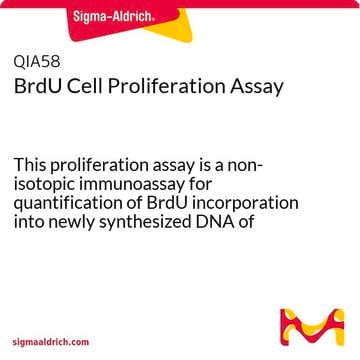APT403
CaspaTag Caspase 3,7 In Situ Assay Kit, Fluorescein
The In Situ Caspase Detection Kit for Flow Cytometry use a novel approach to detect active caspases. The methodology is based on Fluorochrome Inhibitors of Caspases (FLICA).
About This Item
Productos recomendados
Nivel de calidad
reactividad de especies (predicha por homología)
mammals
fabricante / nombre comercial
CaspaTag
Chemicon®
técnicas
activity assay: suitable
flow cytometry: suitable
Nº de acceso NCBI
método de detección
fluorometric
Condiciones de envío
wet ice
Información sobre el gen
human ... CASP3(836)
Descripción general
Caspases have been identified in organisms ranging from C. elegans to humans. The mammalian caspases play distinct roles in apoptosis and inflammation. In apoptosis, caspases are responsible for proteolytic cleavages that lead to cell disassembly (effector caspases), and are involved in upstream regulatory events (initiator caspases). An active caspase consists of two large and two small subunits that form two heterodimers which associate in a tetramer (Walker et al. 1994; Wilson et al. 1994; Rotonda et al. 1996). In common with other proteases, caspases are synthesized as precursors that undergo proteolytic maturation, either autocatalytically or in a cascade by enzymes with similar specificity (Kumar 1999).
Caspase enzymes specifically recognize a 4 or 5 amino acid sequence on the target substrate which necessarily includes an aspartic acid residue. This residue is the target for cleavage, which occurs at the carbonyl end of the aspartic acid residue (Thornberry et al. 1997). Caspases can be detected via immunoprecipitation, immunoblotting techniques using caspase specific antibodies, or by employing fluorochrome substrates which become fluorescent upon cleavage by the caspase.
Test Principle:
CHEMICON′s In Situ Caspase Detection Kits use a novel approach to detect active caspases. The methodology is based on Fluorochrome Inhibitors of Caspases (FLICA). The inhibitors are cell permeable and non-cytotoxic. Once inside the cell, the inhibitor binds covalently to the active caspase (Ekert et al. 1999). This kit uses a carboxyfluorescein-labeled fluoromethyl ketone peptide inhibitor of caspase-3 (FAM-DEVD-FMK), which produces a green fluorescence. When added to a population of cells, the FAM-DEVD-FMK probe enters each cell and covalently binds to a reactive cysteine residue that resides on the large subunit of the active caspase heterodimer, thereby inhibiting further enzymatic activity. The bound labeled reagent is retained within the cell, while any unbound reagent will diffuse out of the cell and is washed away. The green fluorescent signal is a direct measure of the amount of active caspase-3 or caspase-7 present in the cell at the time the reagent was added. Cells that contain the bound labeled reagent can be analyzed by 96-well plate-based fluorometry, fluorescence microscopy, or flow cytometry.
Application:
The CHEMICON In Situ FLICA Caspase-3/7 Detection Kit is a fluorescent-based assay for detection of active caspase-3 or caspase-7 in cells undergoing apoptosis. The kit is for research use only. Not for use in diagnostic or therapeutic procedures.
Aplicación
Apoptosis & Cancer
Componentes
10X Wash Buffer: 60 mL
Fixative: 6 mL
Propidium Iodide: 1 mL at 250 μg/mL, ready-to-use
Hoechst Stain: 1 mL at 200 μg/mL, ready-to-use
Almacenamiento y estabilidad
· Reconstituted FLICA Reagent (150X) should be frozen at -20ºC for up to 6 months, and may be thawed twice during this time. Aliquot into separate amber tubes if desired. Protect from light at all times.
· Store diluted (1X) wash buffer up to -20ºC for 2 weeks.
Información legal
Cláusula de descargo de responsabilidad
Palabra de señalización
Danger
Frases de peligro
Clasificaciones de peligro
Acute Tox. 3 Inhalation - Acute Tox. 4 Dermal - Acute Tox. 4 Oral - Carc. 1B - Eye Irrit. 2 - Muta. 2 - Skin Irrit. 2 - Skin Sens. 1 - STOT SE 2 - STOT SE 3
Órganos de actuación
Eyes,Central nervous system, Respiratory system
Código de clase de almacenamiento
6.1C - Combustible acute toxic Cat.3 / toxic compounds or compounds which causing chronic effects
Certificados de análisis (COA)
Busque Certificados de análisis (COA) introduciendo el número de lote del producto. Los números de lote se encuentran en la etiqueta del producto después de las palabras «Lot» o «Batch»
¿Ya tiene este producto?
Encuentre la documentación para los productos que ha comprado recientemente en la Biblioteca de documentos.
Nuestro equipo de científicos tiene experiencia en todas las áreas de investigación: Ciencias de la vida, Ciencia de los materiales, Síntesis química, Cromatografía, Analítica y muchas otras.
Póngase en contacto con el Servicio técnico








